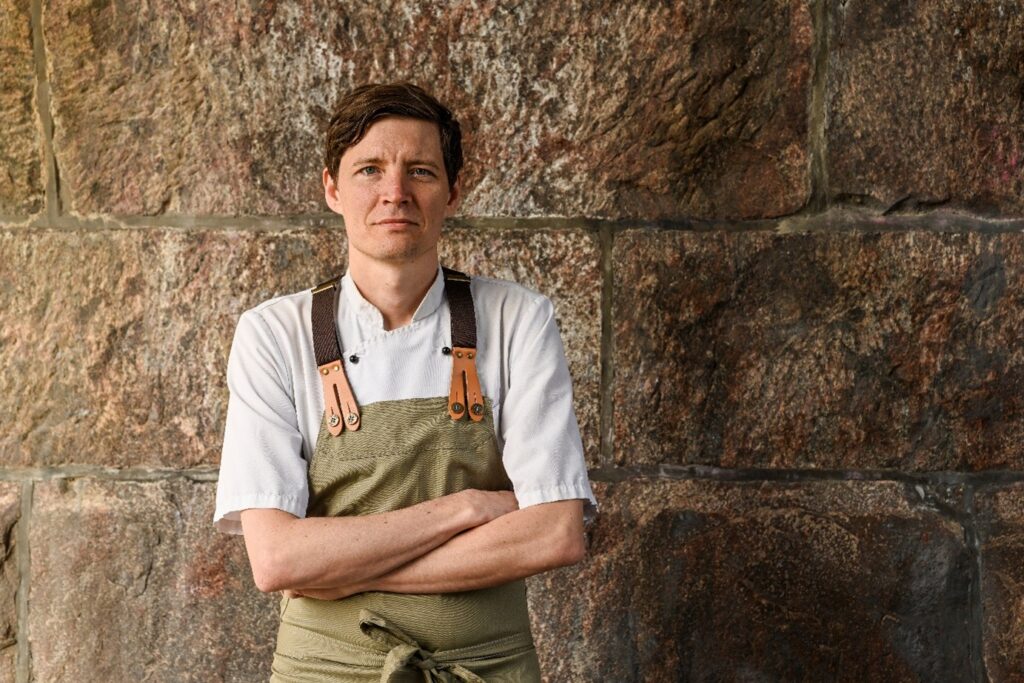A Meeting with the Head Chef: who is Really Hiding behind the Pots in the Dining Hall at Grimeton?
It has been an intense summer since we opened the doors to the dining hall on July 2. As many have surely noticed, we have a new team member, our head chef Daniel Svensson. Daniel has been involved in developing the food concept here at the Grimeton Radio Station World Heritage Site and continues to work with us to drive the Dining Hall forward. We think it’s high time to introduce him more closely through an interview, where you can also learn about his thoughts and visions for the future at Grimeton.
Hello Daniel, it’s great that we get to do an interview with you. Can you tell us a bit about yourself and where you draw inspiration for your cooking?
Hi! I’m 41 years old and have been working with food since high school. I started working part-time at restaurants while studying, and my first job was as a kitchen boy at PA Co in Stockholm. I’ve had a great passion for cooking for as long as I can remember, and my grandmother Ingegerd was my biggest role model. I loved her home cooking and decided I wanted to learn to cook such good food too. After that, things kept moving forward, I’ve been at many different restaurants both in Sweden and abroad. Before coming to Grimeton, I was head chef at Strandbaden in Falkenberg, but I realized it wasn’t the right place for me. I’ve had a longing to fully live out my food philosophy, and now I feel for the first time in my life that I have that opportunity.
I think I draw inspiration from the joy in children’s eyes when they get something really delicious. Just like I felt when I was little and grandmother served me homemade mini meatballs in a small cast iron pan. That feeling is what I want to give to others, especially children, but I think everyone has a little child inside them.
“I’ve had a longing to fully live out my food philosophy, and now I feel for the first time in my life that I have that opportunity.”
Can you explain the concept of “Fish, fowl, or in between”? Why have you chosen not to serve red meat so far?
I’ve tried to create a concept that aligns with Grimeton’s excellent sustainability mindset. Sweden wants World Heritage sites to show the way toward a sustainable and more peaceful world – and naturally, the Dining Hall strives for that too. At the same time, I don’t want to lock the menu into absolute categories. If I find, for example, local game meat with low climate impact, it could very well find its place on the menu. In that case, as part of what we call ‘in between’ – a category that currently mainly includes vegetarian dishes but also allows for flexible, well-thought-out choices. There’s a lot of consideration behind which ingredients we choose to work with – they should be good ingredients in every sense.
What’s the main reason you chose to start working with us?
I feel that the Dining Hall isn’t driven by traditional profit interests – but with the goal of creating accessibility for more people. I think that’s beautiful, and it gives me a very good feeling. There’s something beautiful about being a place where people choose to contribute – not because they have to, but because it feels meaningful. Everything we do in the Dining Hall is part of something bigger: a whole where every visit, every meal, and every conversation helps shape the future of the World Heritage site. We want to be a place that remains, alive and relevant, for generations to come. That’s the driving force in everything we do.
What has been the highlight at Grimeton so far?
That was easy to answer – when I got to go up to what’s called the walkway in one of the towers. It was thrilling and incredibly cool. Then I must also say that all the fantastic encounters I’ve had with guests during the summer have been so much fun. The proximity to guests is definitely a big plus with an open kitchen, especially when food enthusiasts show interest and ask questions about the food. I’m passionate about being able to inspire others!

What is your vision for the Dining Hall?
The Dining Hall shares the Grimeton World Heritage Site’s vision of being an open and inviting place – a meeting place for knowledge, history, food, and people. Both locals and long-distance visitors should feel welcome here, whether they come for coffee, a guided tour, or a booked meeting. At the same time, the concept rests on clear responsibility: to offer good, well-prepared food with low climate impact – at one of the market’s most accessible prices. The ambition is to build up a food concept that not only satisfies but also inspires new thoughts about what sustainable food can be.
Similarly, the shop will be an extension of the Grimeton World Heritage Site’s story – a place where we not only offer good service but also spread knowledge about the site’s history and significance. The assortment reflects our values, with communication as the common thread. Through products from different parts of the world, we want to remind people of our role as a World Heritage site with global reach – a place where local and international meet. In the Shop, there’s a special focus on what we call the Pantry, the shop section that connects the Dining Hall and the Shop. Here we offer carefully selected products, but also ready-made dishes prepared by the chefs in the Dining Hall. It becomes a place where the taste of Grimeton can be taken home or enjoyed on site.
What’s next, what are your thoughts for autumn?
In September we’re launching the Lunch Box, where you’ll be able to buy food, prepared by us, from the shop Tuesday through Saturday throughout the month. If it’s well received, we’ll look into the possibility of continuing it through the end of the year. During this period, the Dining Hall will primarily be reserved for booked groups and conferences, but our visitor center and Shop remain open to all. There you can have coffee or buy a lunch box, prepared in the Dining Hall’s kitchen. Through our Pantry – part of the Shop – we want to keep the place alive even for spontaneous visitors, with simple and good food that aligns with the site’s spirit.
Tell us more about the “Lunch Box” – so it’s not just takeaway?
You might easily think so, but that’s not the case. There will be different dishes, and if you want to heat your lunch box and eat it on site, that will be perfectly fine. We’ve chosen to do this because we don’t yet see enough demand to staff the same way during the low season. At the same time, we want to be able to feed hungry stomachs, so we decided to give the Lunch Box a chance!

What are the plans for the shop going forward?
We hope and believe that the entire operation will grow in line with increased demand from our visitors. My hope is also that the Pantry will be appreciated – and that in turn gives us the opportunity to expand the assortment in the future. This autumn we’ll focus a lot on our delicatessen baskets, which are the perfect Christmas gift if you ask me.
Will it be the same menu returning next summer?
The goal is that we move forward step by step. Right now we’ve just opened and laid the foundation. Of course, I dream that in the future we’ll also be able to offer evening service, with things like food and wine evenings and lots of other fun activities. We’re sticking to our direction and working to take the menu to the next level.
Finally, what do you wish for most right now?
That more people find their way here. That they discover what’s here – the Grimeton Radio Station World Heritage Site, its fantastic environments, its visitor center, the Dining Hall, and the Shop. Yes, what we like to call the world’s place, simply put.
For me, it’s about creating an environment that people want to return to, where it feels meaningful to gather around food, communication, and experiences. And the more people who do that, the better chance we have of keeping the doors open even more often.
About Daniel Svensson
Name: Daniel Svensson
Title: Food Consultant / Head Chef
Works for: The Dining Hall, Grimeton Radio Station World Heritage Site
Education: 3-year chef training at St. Göran’s High School in Stockholm
Favorite food: Waste-smart food, refined leftovers
Favorite ingredient: Home-grown vegetables
Inspired by: The energy from children and young people

